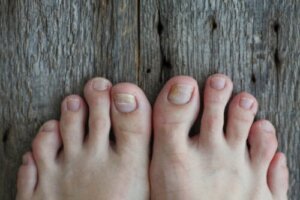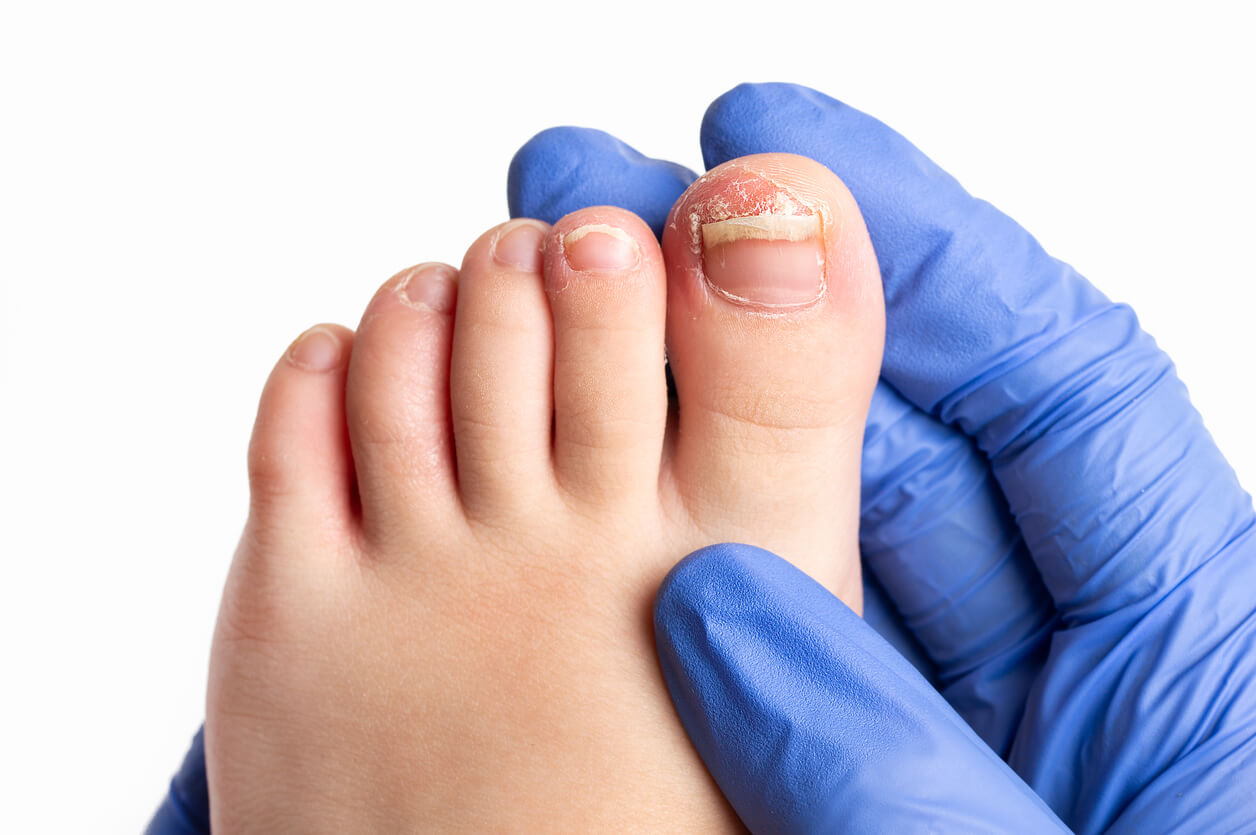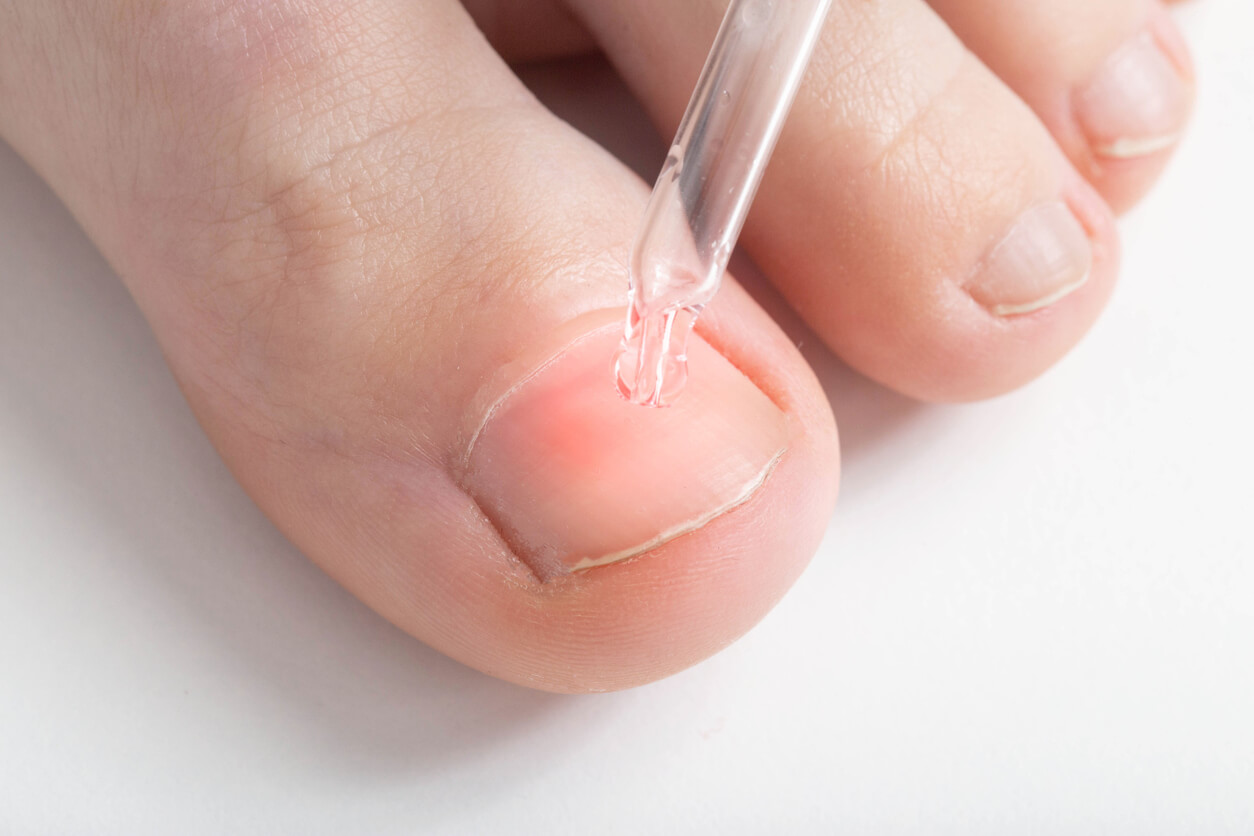How to Treat Nail Fungus in Children?


Written and verified by the dermatologist Maria del Carmen Hernandez
Fungal nail infections in children, also known as onychomycosis, are frequent diseases that bring parents to seek medical consultation. In general, they’re caused by germs such as dermatophytes, yeasts, or saprophytic molds. Whatever their cause, nail fungus in children must be treated specifically to stop its evolution and prevent its spread.
What fungi affect children’s nails?
The most common cause of onychomycosis is infection by the dermatophyte family of fungi, including the following:
- Trichophyton rubrum
- Trichophyton mentagrophytes
- Epidermophyton floccosum
Dermatophytes are responsible for 90% of cases of onychomycosis on the feet and 50% of cases on the hands. However, the yeast Candida albicans is also an important causative agent and accounts for 2 % of onychomycosis of the hands.
Treatment will depend on the agent causing the disease, as not all fungi respond to the same type of medication.
Clinical manifestations of nail fungus in children

Onychomycosis often involves one or more toenails or fingernails, causing them to appear discolored and thickened. In most cases, the most commonly affected nails are those of the halux, or the big toe.
There are several types of onychomycosis, including the following:
- Distal lateral subungual
- Proximal subungual
- Superficial white
- Candida
- By endonix
- Total dystrophic onychomycosis
The most common clinical manifestation of nail fungus in children is distal lateral subungual onychomycosis, which is characterized by the following signs:
- Yellow discoloration of the nail plate
- Separation of the nail plate from the nail bed
- Subungual debris
- Thickening of the lateral and distal sides of the nail
Find out more: 10 Home Remedies for Skin Fungus
Therapeutic options for nail fungus in children
Determining the extent of the infection is important in order to predict the duration of treatment and to evaluate the evolution while treatment lasts.
It’s important to know that nail mycosis may take a year to disappear despite the use of medications. This is because the toenail grows about one millimeter per month and the fingernail grows only slightly faster.
Ciclopirox topical
Ciclopirox 8% topical solution nail polish is an FDA-approved treatment option for use in children 12 years of age and older. This type of topical medication may be more effective in children than in adults and even much more useful, especially for superficial white subungual onychomycosis.
Cyclopirox is one of the most commonly prescribed medications for these infections because it’s very inexpensive and effective.
Topical tavaborol
Topical solutions of efinaconazole 10% and tavaborol 5% are also FDA approved for the treatment of onychomycosis in children 6 years and older.
While these topical medications haven’t shown good effects in adults, they’re very useful in children, as their nails grow faster.

Amorolfine 5% topical lotion
The fungistatic and fungicidal effects of amorolfine 5% topical lotion are produced through the inhibition of ergosterol synthesis. This drug should be applied to the nail twice a week for 6 to 12 months.
Adverse effects of this drug are very infrequent (occurring less than 5% of the time) and are usually mild. For example, reddening of the skin, itching, pain, and a burning sensation. However, studies state that it’s a drug with a lower range of cure and involves long-term treatments.
Find out more: 4 Tricks for Cutting Children’s Fingernails
Itraconazole or oral fluconazole
By combining topical and oral antifungal therapies, we can achieve better results according to a study published in Dermatologic Therapy. The side effects of itraconazole and oral fluconazole are relatively few, very similar, and include the following:
- Nausea
- Vomiting
- Elevation of liver enzymes (transaminases)
- Edema
Oral terbinafine
Terbinafine by mouth is also an option that has been approved by the FDA for use in children. In addition to being effective for the treatment of onychomycosis, it’s very well tolerated by children.
This drug is more effective in children than in adults, with a cure rate greater than 90%.
Griseofulvin
Oral griseofulvin is an FDA-approved drug for use in children, but it’s not effective for all fungal infections. For this reason, it has been replaced by other better options.
Non-drug approaches
There are different therapeutic alternatives for the treatment of onychomycosis and some of them don’t involve drugs. There are options such as laser and photodynamic therapy that have also been shown to be effective.
Case reports have been published in which treatment with Nd:YAG laser has shown good results. In fact, a complete cure is observed in up to 63% of cases according to a study published in the journal Medicine. However, to date, it’s not approved for use in the pediatric age group.
The prevention of nail fungus in children
Recurrence rates of onychomycosis in children are considerable and range from 10 to 53% of cases. This phenomenon is influenced by predisposing factors such as genetics, lifestyle, or the use of inappropriate footwear.
Fungi tend to grow more easily in damp areas, so the idea is to keep feet dry as much as possible to prevent their proliferation. It’s also important to wear shoes in swimming pools and public locker rooms, as they’re frequent sites of contamination.
Finally, teaching people about nail care is one of the most effective ways to prevent infection and modify the risk factors that favor its recurrence. If at any time you notice abnormal changes in your child’s nails, don’t hesitate to go to the dermatologist, as only a professional will be able to prescribe the appropriate treatment.
Fungal nail infections in children, also known as onychomycosis, are frequent diseases that bring parents to seek medical consultation. In general, they’re caused by germs such as dermatophytes, yeasts, or saprophytic molds. Whatever their cause, nail fungus in children must be treated specifically to stop its evolution and prevent its spread.
What fungi affect children’s nails?
The most common cause of onychomycosis is infection by the dermatophyte family of fungi, including the following:
- Trichophyton rubrum
- Trichophyton mentagrophytes
- Epidermophyton floccosum
Dermatophytes are responsible for 90% of cases of onychomycosis on the feet and 50% of cases on the hands. However, the yeast Candida albicans is also an important causative agent and accounts for 2 % of onychomycosis of the hands.
Treatment will depend on the agent causing the disease, as not all fungi respond to the same type of medication.
Clinical manifestations of nail fungus in children

Onychomycosis often involves one or more toenails or fingernails, causing them to appear discolored and thickened. In most cases, the most commonly affected nails are those of the halux, or the big toe.
There are several types of onychomycosis, including the following:
- Distal lateral subungual
- Proximal subungual
- Superficial white
- Candida
- By endonix
- Total dystrophic onychomycosis
The most common clinical manifestation of nail fungus in children is distal lateral subungual onychomycosis, which is characterized by the following signs:
- Yellow discoloration of the nail plate
- Separation of the nail plate from the nail bed
- Subungual debris
- Thickening of the lateral and distal sides of the nail
Find out more: 10 Home Remedies for Skin Fungus
Therapeutic options for nail fungus in children
Determining the extent of the infection is important in order to predict the duration of treatment and to evaluate the evolution while treatment lasts.
It’s important to know that nail mycosis may take a year to disappear despite the use of medications. This is because the toenail grows about one millimeter per month and the fingernail grows only slightly faster.
Ciclopirox topical
Ciclopirox 8% topical solution nail polish is an FDA-approved treatment option for use in children 12 years of age and older. This type of topical medication may be more effective in children than in adults and even much more useful, especially for superficial white subungual onychomycosis.
Cyclopirox is one of the most commonly prescribed medications for these infections because it’s very inexpensive and effective.
Topical tavaborol
Topical solutions of efinaconazole 10% and tavaborol 5% are also FDA approved for the treatment of onychomycosis in children 6 years and older.
While these topical medications haven’t shown good effects in adults, they’re very useful in children, as their nails grow faster.

Amorolfine 5% topical lotion
The fungistatic and fungicidal effects of amorolfine 5% topical lotion are produced through the inhibition of ergosterol synthesis. This drug should be applied to the nail twice a week for 6 to 12 months.
Adverse effects of this drug are very infrequent (occurring less than 5% of the time) and are usually mild. For example, reddening of the skin, itching, pain, and a burning sensation. However, studies state that it’s a drug with a lower range of cure and involves long-term treatments.
Find out more: 4 Tricks for Cutting Children’s Fingernails
Itraconazole or oral fluconazole
By combining topical and oral antifungal therapies, we can achieve better results according to a study published in Dermatologic Therapy. The side effects of itraconazole and oral fluconazole are relatively few, very similar, and include the following:
- Nausea
- Vomiting
- Elevation of liver enzymes (transaminases)
- Edema
Oral terbinafine
Terbinafine by mouth is also an option that has been approved by the FDA for use in children. In addition to being effective for the treatment of onychomycosis, it’s very well tolerated by children.
This drug is more effective in children than in adults, with a cure rate greater than 90%.
Griseofulvin
Oral griseofulvin is an FDA-approved drug for use in children, but it’s not effective for all fungal infections. For this reason, it has been replaced by other better options.
Non-drug approaches
There are different therapeutic alternatives for the treatment of onychomycosis and some of them don’t involve drugs. There are options such as laser and photodynamic therapy that have also been shown to be effective.
Case reports have been published in which treatment with Nd:YAG laser has shown good results. In fact, a complete cure is observed in up to 63% of cases according to a study published in the journal Medicine. However, to date, it’s not approved for use in the pediatric age group.
The prevention of nail fungus in children
Recurrence rates of onychomycosis in children are considerable and range from 10 to 53% of cases. This phenomenon is influenced by predisposing factors such as genetics, lifestyle, or the use of inappropriate footwear.
Fungi tend to grow more easily in damp areas, so the idea is to keep feet dry as much as possible to prevent their proliferation. It’s also important to wear shoes in swimming pools and public locker rooms, as they’re frequent sites of contamination.
Finally, teaching people about nail care is one of the most effective ways to prevent infection and modify the risk factors that favor its recurrence. If at any time you notice abnormal changes in your child’s nails, don’t hesitate to go to the dermatologist, as only a professional will be able to prescribe the appropriate treatment.
All cited sources were thoroughly reviewed by our team to ensure their quality, reliability, currency, and validity. The bibliography of this article was considered reliable and of academic or scientific accuracy.
- Youssef AB, Kallel A, Azaiz Z, et al. Onychomycosis: Which fungal species are involved? Experience of the Laboratory of Parasitology-Mycology of the Rabta Hospital of Tunis. J Mycol Med. 2018 Dec;28(4):651-654. doi: 10.1016/j.mycmed.2018.07.005. Epub 2018 Aug 11. PMID: 30107987.
- Gupta AK, Mays RR, Versteeg SG, Shear NH, Friedlander SF. Onychomycosis in children: Safety and efficacy of antifungal agents. Pediatr Dermatol. 2018 Sep;35(5):552-559. doi: 10.1111/pde.13561. Epub 2018 Jun 26. PMID: 29943838.
- Gupta AK, Venkataraman M, Shear NH, Piguet V. Onychomycosis in children – review on treatment and management strategies. J Dermatolog Treat. 2020 Aug 26:1-12. doi: 10.1080/09546634.2020.1810607. Epub ahead of print. PMID: 32799713.
- Gupta AK, Cooper EA, Lynde CW. The efficacy and safety of terbinafine in children. Dermatol Clin. 2003 Jul;21(3):511-20. doi: 10.1016/s0733-8635(03)00029-9. PMID: 12956204.
This text is provided for informational purposes only and does not replace consultation with a professional. If in doubt, consult your specialist.








